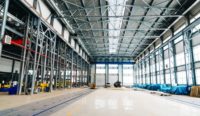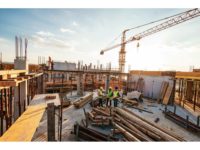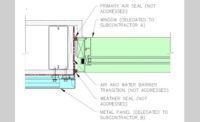Two industrial-modernist warehouses housing Woodinville Whiskey’s small-batch bottling, barreling and aging facilities recently opened in rural Quincy, Washington.
Designed by Seattle-based Graham Baba Architects, the completed buildings are two of ultimately six 25,000 square-foot structures planned on the 10-acre parcel for the whiskey brand; the third will open this July.
Maintaining the simple, rectilinear gabled form and dark brown hue of the Woodinville distillery, located 160 miles away (in Woodinville), the new complex’s structures are clad in dark metal siding and Kebony modified wood. Large Corten-clad sliding barn doors and bands of Corten siding at key locations combine to evoke the warmth and character of the whiskey.
According to Graham Baba Architects associate principal Susan Tillack, who designed the project: “Prefabricated metal buildings are taken to a higher level here, with attention to key details and a judicious use of materials where they really count – in places they can be touched and seen, on the entries and street-facing facades.”
Selected materials were chosen for their aesthetics, durability, sustainability, ease of construction and connection to the materiality of the original distillery located in Woodinville, Washington. “Kebony was a natural choice for the front facades as the clients wanted the warmth of wood, but the material had to be durable enough to withstand the extreme heat and cold of eastern Washington’s weather, without requiring continuous maintenance,” Tillack said. “For us, it was a perect fit due to the beauty of the product, its sustainability and the ease of installation with the use of Kebony’s rainscreen system.”
The transition between office and process areas is demarcated with a long vertical window that folds from wall to ceiling, transforming into a skylight. Horizontal windows on the north wall of the processing area frame the adjacent agricultural landscape and farmstead. A row of skylights provides natural daylighting into the processing space, while south-facing photovoltaic rooftop panels provide a renewable source of electricity.
Selective elements demolished at the Woodinville distillery (steel and old growth Douglas fir stairs and steel railings) were salvaged and repurposed for the new complex, keeping them out of the landfill while creating a spiritual and physical link between the new facility and the distillery. Before the stair was moved to its new location, patrons of Woodinville signed a steel stringer, further connecting the past to the future. On the exterior, a huge “Woodinville Whiskey Co.” sign is rendered as a semi-transparent super-graphic painted onto the north façade of the building, announcing the brand to passing motorists, recalling signs such as those found on the sides of distilleries and rickhouses throughout rural and agricultural regions from Kentucky to Scotland.
Founded by best friends Orlin Sorensen and Brett Carlile, the company and its operations were created as a place where whiskey is produced in a craft environment, using high-quality, local ingredients and advanced distilling technology.




